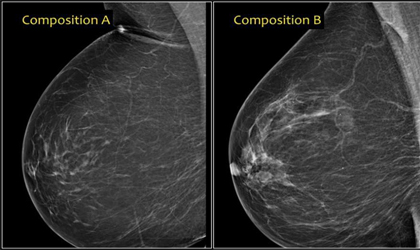Last May, the Vermont Legislature passed a law requiring providers to inform patients directly of their breast density. This information has previously been available to the provider in the mammogram report.

Image A, left, is an example of a breast in the "fatty" category of density; image B, right, is an example of the "scattered fibroglandular" category. (Photos: Courtesy of Sally Herschorn, M.D.)
Last May, the Vermont Legislature passed a law requiring providers to inform patients directly of their breast density. This information has previously been available to the provider in the mammogram report.
About 40 percent to 50 percent of women have dense breasts, a normal condition in which breasts have less fat than they do glandular or connective tissue and make mammograms more difficult to interpret. This is the number-one reason for cancers missed by mammography, and women with dense breast tissue are also at a slightly increased risk for breast cancer.
While breast density is a continuum, radiologists divide it into four categories:
- almost entirely fatty
- scattered fibroglandular
- heterogeneously dense
- extremely dense
On January 15, the new law went into effect and now, all patients will be directly informed of their density category. Those who fall into the latter two categories will receive a letter from the University of Vermont Medical Center’s Breast Imaging Division sharing this information and encouraging them to talk with their physician about breast density and their ideal personal screening regimen. Options available her include digital breast tomosynthesis (DBT), all supplementary screening options provide increased cancer detection, but at the expense of additional false positives. Insurance coverage for some may be an issue. There are no current medical society guidelines or best practices to determine who would benefit from supplementary screening, and physicians are encouraged to discuss a patient’s personal values and preferences. It is also a good time to review a patient’s risk factors for breast cancer.
Sally Herschorn, M.D., UVM Cancer Center member and associate professor of radiology, was interviewed for this article. Watch a recent "Across the Fence" interview here, and an ABC22/Fox44 local television news interview featuring Herschorn here.